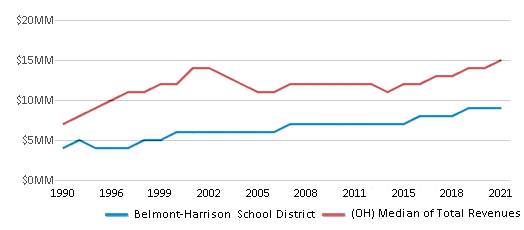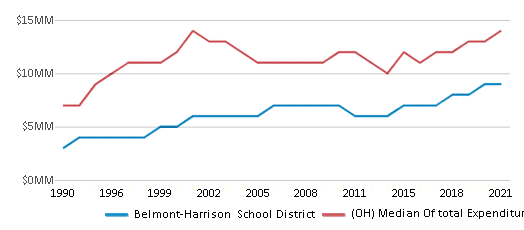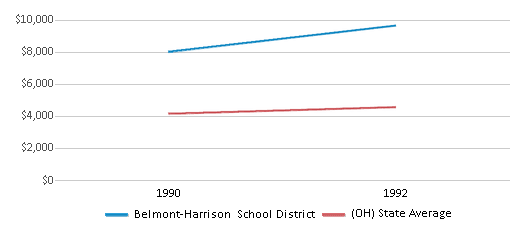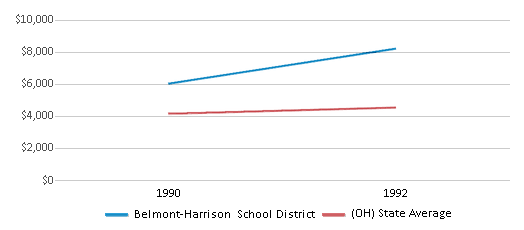Top Rankings
Belmont-Harrison School District ranks among the top 20% of public school district in Ohio for:
Category
Attribute
Student Attention
Lowest student:teacher ratio (Top 1%)
For the 2025 school year, there are 2 public schools serving 420 students in Belmont-Harrison School District.
Public Schools in Belmont-Harrison School District have a diversity score of 0.04, which is less than the Ohio public school average of 0.53.
Minority enrollment is 2% of the student body (majority Hispanic and Asian), which is less than the Ohio public school average of 34% (majority Black).
Overview
This School District
This State (OH)
# Schools
2 Schools
3,572 Schools
# Students
420 Students
1,670,552 Students
# Teachers
46 Teachers
96,800 Teachers
Student : Teacher Ratio
9:1
9:1
Students by Ethnicity:
Diversity Score
0.04
0.53
# American Indian Students
n/a
2,370 Students
% American Indian Students
n/a
n/a
# Asian Students
1 Student
49,192 Students
% Asian Students
n/a
3%
# Hispanic Students
1 Student
130,270 Students
% Hispanic Students
n/a
8%
# Black Students
n/a
283,872 Students
% Black Students
n/a
17%
# White Students
412 Students
1,098,036 Students
% White Students
98%
66%
# Hawaiian Students
n/a
1,718 Students
% Hawaiian Students
n/a
n/a
# Two or more races Students
6 Students
105,080 Students
% of Two or more races Students
2%
6%
Students by Grade:
# Students in PK Grade:
-
46,438
# Students in K Grade:
-
117,523
# Students in 1st Grade:
-
119,240
# Students in 2nd Grade:
-
123,668
# Students in 3rd Grade:
-
116,979
# Students in 4th Grade:
-
120,578
# Students in 5th Grade:
-
121,564
# Students in 6th Grade:
-
121,429
# Students in 7th Grade:
-
123,631
# Students in 8th Grade:
-
124,479
# Students in 9th Grade:
61
136,464
# Students in 10th Grade:
113
133,227
# Students in 11th Grade:
122
135,708
# Students in 12th Grade:
124
129,624
# Ungraded Students:
-
-
District Revenue and Spending
The revenue/student of $22,276 is higher than the state median of $17,287. The school district revenue/student has grown by 177% over four school years.
The school district's spending/student of $20,757 is higher than the state median of $17,235. The school district spending/student has grown by 244% over four school years.
Total Revenue
$9 MM
$28,879 MM

Spending
$9 MM
$28,792 MM

Revenue / Student (91-92)
$22,276
$17,287

Spending / Student (91-92)
$20,757
$17,235

Best Belmont-Harrison School District Public Schools (2025)
School
(Math and Reading Proficiency)
(Math and Reading Proficiency)
Location
Grades
Students
Rank: n/an/a
Belmont Career Center
Vocational School
68090 Hammond Rd
Saint Clairsville, OH 43950
(740) 695-9130
Saint Clairsville, OH 43950
(740) 695-9130
Grades: 7-12
| 328 students
Rank: n/an/a
Harrison Career Center
Vocational School
82500 Cadiz Jewett Rd
Cadiz, OH 43907
(740) 942-2148
Cadiz, OH 43907
(740) 942-2148
Grades: 9-12
| 92 students
Frequently Asked Questions
How many schools belong to Belmont-Harrison School District?
Belmont-Harrison School District manages 2 public schools serving 420 students.
What is the racial composition of students in Belmont-Harrison School District?
98% of Belmont-Harrison School District students are White, and 2% of students are Two or more races.
What is the student/teacher ratio of Belmont-Harrison School District?
Belmont-Harrison School District has a student/teacher ratio of 9:1, which is lower than the Ohio state average of 17:1.
What is Belmont-Harrison School District's spending/student ratio?
The school district's spending/student of $20,757 is higher than the state median of $17,235. The school district spending/student has grown by 244% over four school years.
Recent Articles

Year-Round Or Traditional Schedule?
Which is more appropriate for your child? A year-round attendance schedule or traditional schedule? We look at the pros and cons.

Why You Should Encourage Your Child to Join a Sports Team
Participating in team sports has a great many benefits for children, there is no doubt. In this article you will learn what those benefits are.

White Students are Now the Minority in U.S. Public Schools
Increasing birth rates among immigrant families from Asia and Central and South America, combined with lower birth rates among white families, means that for the first time in history, public school students in the United States are majority-minority. This shift in demographics poses difficulties for schools as they work to accommodate children of varying language abilities and socio-economic backgrounds.





